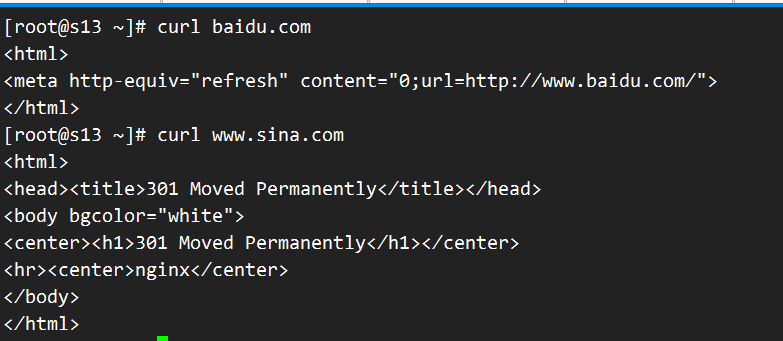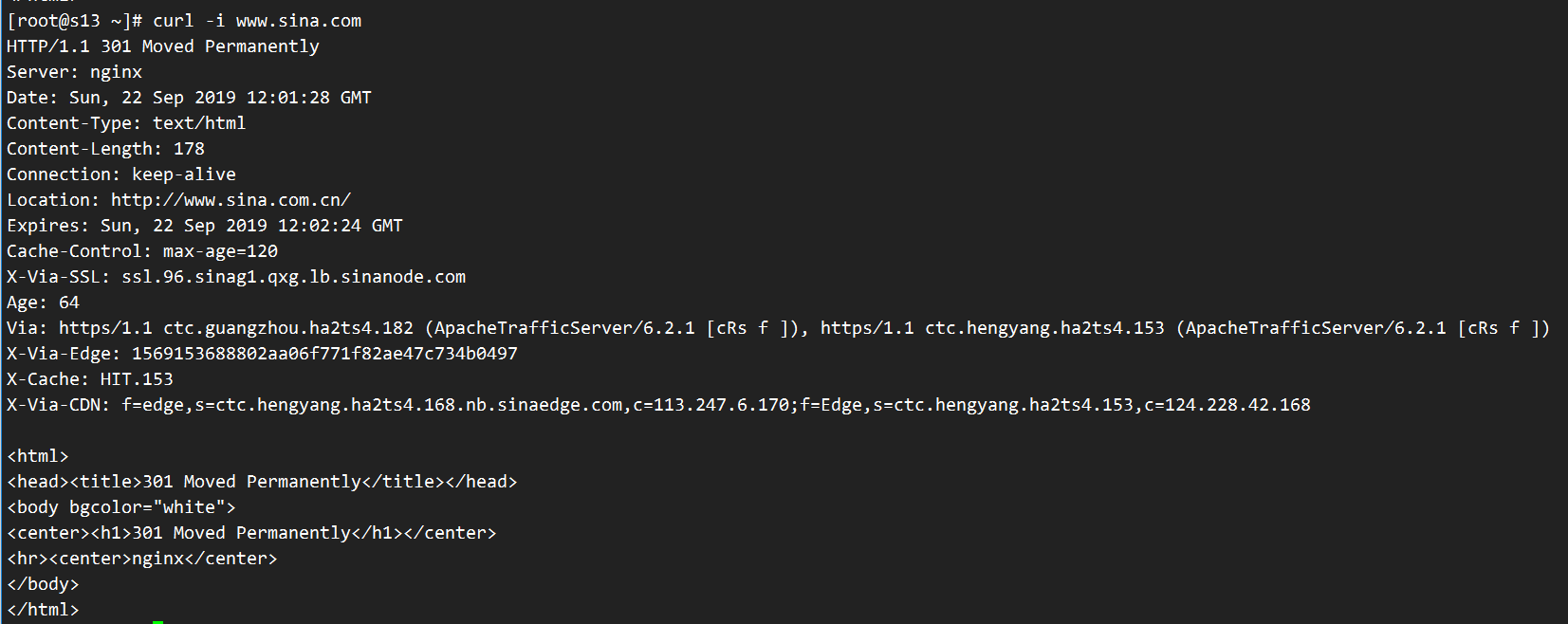curl速查手册
curl就是客户端(client)的URL工具的意思。
熟练curl取代postman
基本用法
查看网站源码
curl baidu.com

将服务器的回应保存成文件,等同于wget
curl -o baidu.txt baidu.com
重定向,针对301
默认不跟随重定向
curl -L www.sina.com
HEAD,显示头信息
# -i参数可以显示http response的头信息,连同网页代码一起
# -I参数则是只显示http response的头信息
curl -i www.sina.com

发送表单信息
# get
curl example.com/form.cgi?data=xxx
# post
curl -X POST --data "data=xxx" example.com/form.cgi
发送POST请求的数据体
curl -d 'login=emma&password=123' -X POST https://google.com/login
curl -d 'login=emma' -d 'password=123' -X POST https://google.com/login
# 使用-d参数以后,HTTP请求会自动加上标头Content-Type: application/x-www-form-urlencoded
# 并且会自动将请求转为POST方法,因此可以省略-X POST
# -d 参数可以读取本地文本文件的数据,向服务器发送
curl -d '@data.txt' https://google.com/login
将发送的数据进行URL编码
# 让curl给数据表单编码,数据有空格需要进行URL编码
curl -X POST --data-urlencode "data=April 1" example.com/form.cgi
构造查询字符串
# get请求
# -G用来构造URL的查询字符串
curl -G -d 'q=kitties' -d 'count=20' https://google.com/search
HTTP动词,-X
curl -X POST www.example.com
curl -X DELETE www.example.com
文件上传???
curl --form upload=@localfilename --form press=OK [URL]
上传二进制文件
curl -F 'file=@photo.png' https://google.com/profile
# 上面命令会给HTTP请求加上标头Content-Type: multipart/form-data
# 然后将文件 photo.png作为file字段上传
# -F参数可以指定MIME类型
curl -F 'file=@photo.png;type=image/png' https://google.com/profile
# -F参数可以指定文件名,服务器接收到的文件名为me.png
curl -F 'file=@photo.png;filename=me.png' https://google.com/profile
Referer字段
表示你是从哪里跳转过来的
# -e --referer
curl --referer http://www.example.com http://www.example.com
# -H参数可以通过直接添加标头Referer,达到同样效果
curl -H 'Referer:https://google.com?q=example' https://www.example.com
增加头信息
# -H --header
curl --header "Content-Type:application/json" http://example.com
curl -H 'Accept-Language: en-US' -H 'Secret-Message: xyzzy' https://google.com
User Agent字段
表示客户端的设备信息,服务器有时会根据这个字段,针对不同设备,返回不同格式的网页,比如手机版和桌面版
# Wdindows Chrome
Mozilla/5.0 (Windows NT 10.0; Win64; x64) AppleWebKit/537.36 (KHTML, like Gecko) Chrome/77.0.3865.90 Safari/537.36
# -A --user-agent
curl --user-agent "[User Agent]" [URL]
# 也可以通过-H参数直接指定
curl -H 'User-Agent: php/1.0' https://gogole.com
Cookie
# -b --cookie
curl --cookie "name=xxx" www.example.com
# cookie的值,可以从http response头信息的'Set-Cookie'字段中得到
# -c cookie-file可以保存服务器返回的cookie文件,
# -b cookie-file可以使用这个文件作为cookie信息,进行后续的请求
curl -c cookies.txt http://example.com
curl -b cookies.txt http://example.com
发送JSON请求
curl -d '{"login": "emma", "pass": "123"}' -H 'Content-Type: application/json' https://google.com/login
HTTP认证
# -u --user
curl --user name:password example.com
curl https://bob:12345@google.com/login
# 上面命令能够识别 URL 里面的用户名和密码,将其转为上个例子里面的 HTTP 标头。
指定代理
curl -x socks5://james:cats@mtproxy.com:8080 www.baidu.com
curl -x 127.0.0.1:8081 www.baidu.com
# 代理协议默认为HTTP

调试
模拟网速环境
限制HTTP请求和回应的宽带,模拟慢网速的环境
curl --limit-rate 200k https://google.com
显示通信过程
# -v参数可以显示一次http通信的整个过程,包括端口连接和http request头信息
curl -v www.sina.com
# 查看更详细的通信过程,输出原始的二进制数据
curl --trace output.txt www.sina.com
curl --trace-ascii output.txt www.sina.com

不输出错误信息和进度信息
curl -s https://www.example.com
# 不产生任何输出
curl -s -o /dev/null https://google.com
只输出错误信息
curl -S https://example.com
跳过SSL检测
curl -k https://www.example.com
查看帮助
[root@s13 ~]# curl -h
Usage: curl [options...] <url>
Options: (H) means HTTP/HTTPS only, (F) means FTP only
--anyauth Pick "any" authentication method (H)
-a, --append Append to target file when uploading (F/SFTP)
--basic Use HTTP Basic Authentication (H)
--cacert FILE CA certificate to verify peer against (SSL)
--capath DIR CA directory to verify peer against (SSL)
-E, --cert CERT[:PASSWD] Client certificate file and password (SSL)
--cert-type TYPE Certificate file type (DER/PEM/ENG) (SSL)
--ciphers LIST SSL ciphers to use (SSL)
--compressed Request compressed response (using deflate or gzip)
-K, --config FILE Specify which config file to read
--connect-timeout SECONDS Maximum time allowed for connection
-C, --continue-at OFFSET Resumed transfer offset
-b, --cookie STRING/FILE String or file to read cookies from (H)
-c, --cookie-jar FILE Write cookies to this file after operation (H)
--create-dirs Create necessary local directory hierarchy
--crlf Convert LF to CRLF in upload
--crlfile FILE Get a CRL list in PEM format from the given file
-d, --data DATA HTTP POST data (H)
--data-ascii DATA HTTP POST ASCII data (H)
--data-binary DATA HTTP POST binary data (H)
--data-urlencode DATA HTTP POST data url encoded (H)
--delegation STRING GSS-API delegation permission
--digest Use HTTP Digest Authentication (H)
--disable-eprt Inhibit using EPRT or LPRT (F)
--disable-epsv Inhibit using EPSV (F)
-D, --dump-header FILE Write the headers to this file
--egd-file FILE EGD socket path for random data (SSL)
--engine ENGINGE Crypto engine (SSL). "--engine list" for list
-f, --fail Fail silently (no output at all) on HTTP errors (H)
-F, --form CONTENT Specify HTTP multipart POST data (H)
--form-string STRING Specify HTTP multipart POST data (H)
--ftp-account DATA Account data string (F)
--ftp-alternative-to-user COMMAND String to replace "USER [name]" (F)
--ftp-create-dirs Create the remote dirs if not present (F)
--ftp-method [MULTICWD/NOCWD/SINGLECWD] Control CWD usage (F)
--ftp-pasv Use PASV/EPSV instead of PORT (F)
-P, --ftp-port ADR Use PORT with given address instead of PASV (F)
--ftp-skip-pasv-ip Skip the IP address for PASV (F)
--ftp-pret Send PRET before PASV (for drftpd) (F)
--ftp-ssl-ccc Send CCC after authenticating (F)
--ftp-ssl-ccc-mode ACTIVE/PASSIVE Set CCC mode (F)
--ftp-ssl-control Require SSL/TLS for ftp login, clear for transfer (F)
-G, --get Send the -d data with a HTTP GET (H)
-g, --globoff Disable URL sequences and ranges using {} and []
-H, --header LINE Custom header to pass to server (H)
-I, --head Show document info only
-h, --help This help text
--hostpubmd5 MD5 Hex encoded MD5 string of the host public key. (SSH)
-0, --http1.0 Use HTTP 1.0 (H)
--ignore-content-length Ignore the HTTP Content-Length header
-i, --include Include protocol headers in the output (H/F)
-k, --insecure Allow connections to SSL sites without certs (H)
--interface INTERFACE Specify network interface/address to use
-4, --ipv4 Resolve name to IPv4 address
-6, --ipv6 Resolve name to IPv6 address
-j, --junk-session-cookies Ignore session cookies read from file (H)
--keepalive-time SECONDS Interval between keepalive probes
--key KEY Private key file name (SSL/SSH)
--key-type TYPE Private key file type (DER/PEM/ENG) (SSL)
--krb LEVEL Enable Kerberos with specified security level (F)
--libcurl FILE Dump libcurl equivalent code of this command line
--limit-rate RATE Limit transfer speed to this rate
-l, --list-only List only names of an FTP directory (F)
--local-port RANGE Force use of these local port numbers
-L, --location Follow redirects (H)
--location-trusted like --location and send auth to other hosts (H)
-M, --manual Display the full manual
--mail-from FROM Mail from this address
--mail-rcpt TO Mail to this receiver(s)
--mail-auth AUTH Originator address of the original email
--max-filesize BYTES Maximum file size to download (H/F)
--max-redirs NUM Maximum number of redirects allowed (H)
-m, --max-time SECONDS Maximum time allowed for the transfer
--metalink Process given URLs as metalink XML file
--negotiate Use HTTP Negotiate Authentication (H)
-n, --netrc Must read .netrc for user name and password
--netrc-optional Use either .netrc or URL; overrides -n
--netrc-file FILE Set up the netrc filename to use
-N, --no-buffer Disable buffering of the output stream
--no-keepalive Disable keepalive use on the connection
--no-sessionid Disable SSL session-ID reusing (SSL)
--noproxy List of hosts which do not use proxy
--ntlm Use HTTP NTLM authentication (H)
-o, --output FILE Write output to <file> instead of stdout
--pass PASS Pass phrase for the private key (SSL/SSH)
--post301 Do not switch to GET after following a 301 redirect (H)
--post302 Do not switch to GET after following a 302 redirect (H)
--post303 Do not switch to GET after following a 303 redirect (H)
-#, --progress-bar Display transfer progress as a progress bar
--proto PROTOCOLS Enable/disable specified protocols
--proto-redir PROTOCOLS Enable/disable specified protocols on redirect
-x, --proxy [PROTOCOL://]HOST[:PORT] Use proxy on given port
--proxy-anyauth Pick "any" proxy authentication method (H)
--proxy-basic Use Basic authentication on the proxy (H)
--proxy-digest Use Digest authentication on the proxy (H)
--proxy-negotiate Use Negotiate authentication on the proxy (H)
--proxy-ntlm Use NTLM authentication on the proxy (H)
-U, --proxy-user USER[:PASSWORD] Proxy user and password
--proxy1.0 HOST[:PORT] Use HTTP/1.0 proxy on given port
-p, --proxytunnel Operate through a HTTP proxy tunnel (using CONNECT)
--pubkey KEY Public key file name (SSH)
-Q, --quote CMD Send command(s) to server before transfer (F/SFTP)
--random-file FILE File for reading random data from (SSL)
-r, --range RANGE Retrieve only the bytes within a range
--raw Do HTTP "raw", without any transfer decoding (H)
-e, --referer Referer URL (H)
-J, --remote-header-name Use the header-provided filename (H)
-O, --remote-name Write output to a file named as the remote file
--remote-name-all Use the remote file name for all URLs
-R, --remote-time Set the remote file's time on the local output
-X, --request COMMAND Specify request command to use
--resolve HOST:PORT:ADDRESS Force resolve of HOST:PORT to ADDRESS
--retry NUM Retry request NUM times if transient problems occur
--retry-delay SECONDS When retrying, wait this many seconds between each
--retry-max-time SECONDS Retry only within this period
-S, --show-error Show error. With -s, make curl show errors when they occur
-s, --silent Silent mode. Don't output anything
--socks4 HOST[:PORT] SOCKS4 proxy on given host + port
--socks4a HOST[:PORT] SOCKS4a proxy on given host + port
--socks5 HOST[:PORT] SOCKS5 proxy on given host + port
--socks5-basic Enable username/password auth for SOCKS5 proxies
--socks5-gssapi Enable GSS-API auth for SOCKS5 proxies
--socks5-hostname HOST[:PORT] SOCKS5 proxy, pass host name to proxy
--socks5-gssapi-service NAME SOCKS5 proxy service name for gssapi
--socks5-gssapi-nec Compatibility with NEC SOCKS5 server
-Y, --speed-limit RATE Stop transfers below speed-limit for 'speed-time' secs
-y, --speed-time SECONDS Time for trig speed-limit abort. Defaults to 30
--ssl Try SSL/TLS (FTP, IMAP, POP3, SMTP)
--ssl-reqd Require SSL/TLS (FTP, IMAP, POP3, SMTP)
-2, --sslv2 Use SSLv2 (SSL)
-3, --sslv3 Use SSLv3 (SSL)
--ssl-allow-beast Allow security flaw to improve interop (SSL)
--stderr FILE Where to redirect stderr. - means stdout
--tcp-nodelay Use the TCP_NODELAY option
-t, --telnet-option OPT=VAL Set telnet option
--tftp-blksize VALUE Set TFTP BLKSIZE option (must be >512)
-z, --time-cond TIME Transfer based on a time condition
-1, --tlsv1 Use => TLSv1 (SSL)
--tlsv1.0 Use TLSv1.0 (SSL)
--tlsv1.1 Use TLSv1.1 (SSL)
--tlsv1.2 Use TLSv1.2 (SSL)
--trace FILE Write a debug trace to the given file
--trace-ascii FILE Like --trace but without the hex output
--trace-time Add time stamps to trace/verbose output
--tr-encoding Request compressed transfer encoding (H)
-T, --upload-file FILE Transfer FILE to destination
--url URL URL to work with
-B, --use-ascii Use ASCII/text transfer
-u, --user USER[:PASSWORD] Server user and password
--tlsuser USER TLS username
--tlspassword STRING TLS password
--tlsauthtype STRING TLS authentication type (default SRP)
--unix-socket FILE Connect through this UNIX domain socket
-A, --user-agent STRING User-Agent to send to server (H)
-v, --verbose Make the operation more talkative
-V, --version Show version number and quit
-w, --write-out FORMAT What to output after completion
--xattr Store metadata in extended file attributes
-q If used as the first parameter disables .curlrc
参考: